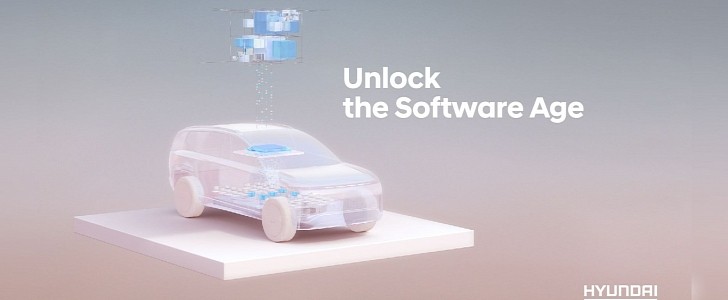Hyundai introduced its future EV platform in March, but that was just the beginning of laying down its plans for the future. With the Integrated Modular Architecture (IMA), the company solved the hardware needs it will have for its future cars. We knew Hyundai was planning to give over-the-air (OTA) updates for its vehicles, but now it disclosed the strategy to get there. Starting in 2023, all new Hyundai vehicles will get Connected Car Services (CCS) and OTA updates capability.
That will include electric vehicles and those powered by combustion engines as well. According to Hyundai, all of them will become Software-Defined Vehicles (SDVs), with a total of 20 million cars able to be defined as such by 2025. That will require something Hyundai is calling a Connected Car Operating System (ccOS). Curiously, the company did not say when it intends to install this new software in its cars. Developed by Hyundai, the operating system “will offer customers personalized services and process data at blazing speeds.”
That obviously depends on the infrastructure of the countries where these vehicles are sold and rely on 5G. Perhaps this is why the Korean carmaker was so careful to say it will expand OTA update availability “across vehicle models in global market regions able to receive Connected Car Services (CCS).”
With OTA updates and CCS, Hyundai also plans to offer Feature on Demand (FoD) services in 2023. With it, the Korean carmaker said customers will have “the ability to select and purchase functions and features that meet their needs and tastes, and the freedom to create vehicles that best match their lifestyles.”
To ensure the company’s software is up to these challenges, Hyundai will invest 18 trillion won ($12.6 billion at the current exchange rate) in its Global Software Center and its R&D headquarters. The investments will include hiring the “world's best software developers” and developing “devices and services that prioritize UX to bring new experiences to the mobility market.”
As we told our readers back in March, the new IMA platform is based on the E-GMP, and it will be divided into two architectures: eM, for passenger cars, which will work at 800V, and eS, for Purpose Built Vehicles (PBVs), good for 400V. The eM platform has a pretty ambitious goal: to “provide a 50 percent improvement in driving range on a single charge compared to current EVs.”
That obviously depends on the infrastructure of the countries where these vehicles are sold and rely on 5G. Perhaps this is why the Korean carmaker was so careful to say it will expand OTA update availability “across vehicle models in global market regions able to receive Connected Car Services (CCS).”
With OTA updates and CCS, Hyundai also plans to offer Feature on Demand (FoD) services in 2023. With it, the Korean carmaker said customers will have “the ability to select and purchase functions and features that meet their needs and tastes, and the freedom to create vehicles that best match their lifestyles.”
To ensure the company’s software is up to these challenges, Hyundai will invest 18 trillion won ($12.6 billion at the current exchange rate) in its Global Software Center and its R&D headquarters. The investments will include hiring the “world's best software developers” and developing “devices and services that prioritize UX to bring new experiences to the mobility market.”
As we told our readers back in March, the new IMA platform is based on the E-GMP, and it will be divided into two architectures: eM, for passenger cars, which will work at 800V, and eS, for Purpose Built Vehicles (PBVs), good for 400V. The eM platform has a pretty ambitious goal: to “provide a 50 percent improvement in driving range on a single charge compared to current EVs.”

















